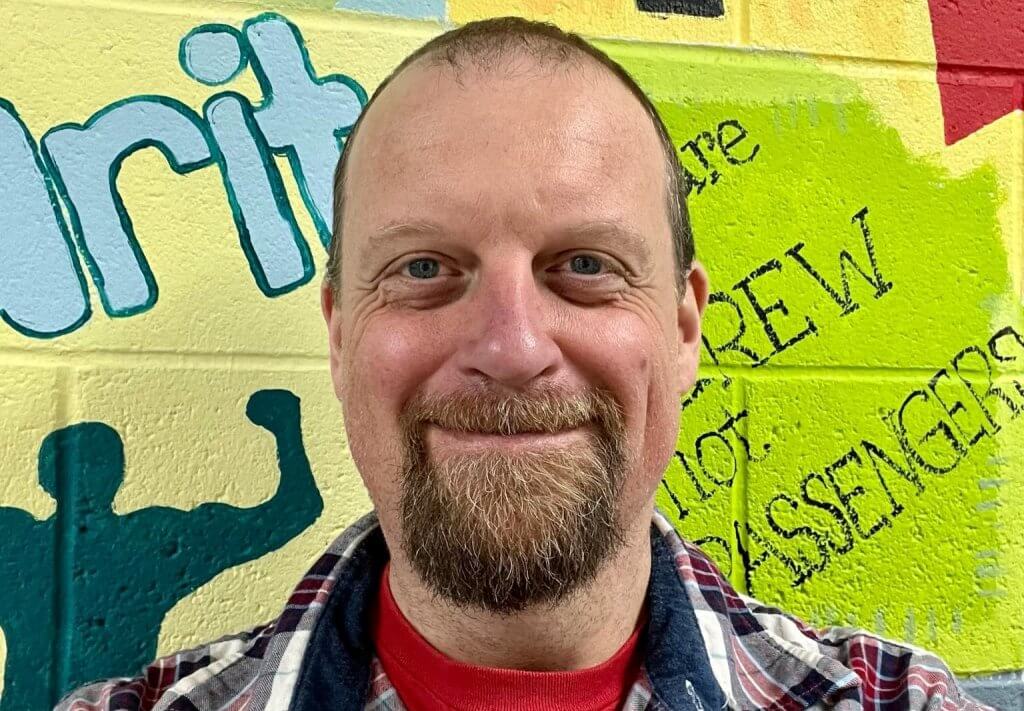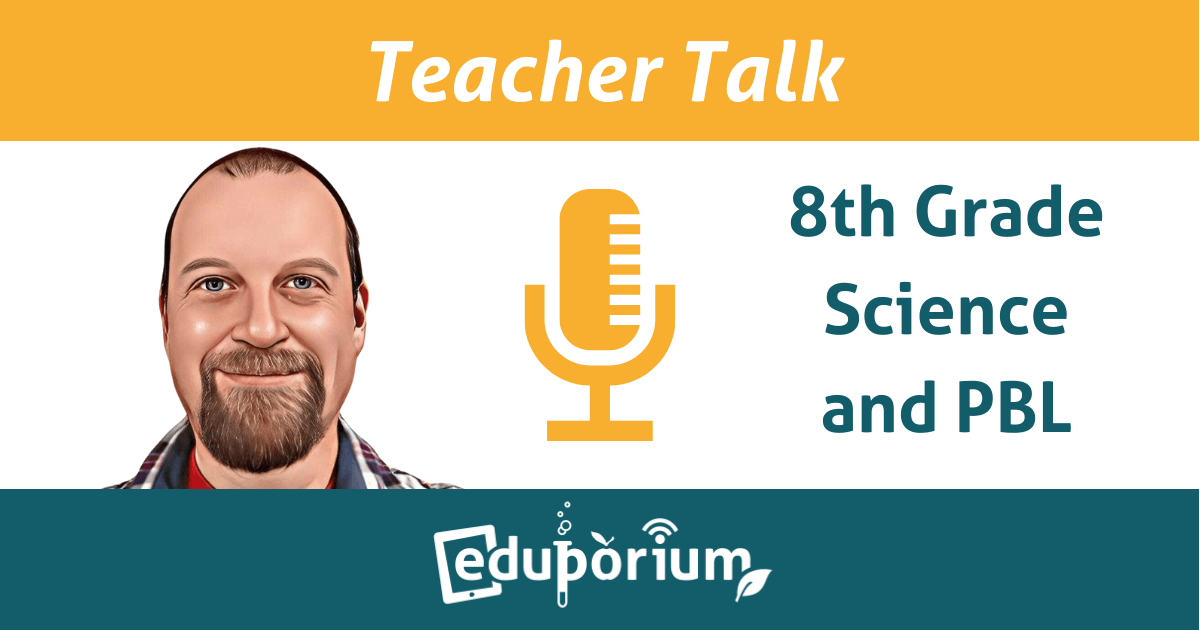Project-based learning, or PBL, is one of the best ways to teach STEM. Students can really see concepts in action while practicing important SEL skills like teamwork and responsibility. And, the hands-on projects help keep students focused on applying what they’ve learned. With project-based learning, they even get a glimpse of real-life applications for STEM, potentially sparking a lifelong passion.
Science educator Jeremy Jorgensen knows all about these benefits. For this month’s Teacher Talk feature, we chatted all about how he incorporates project-based learning into the classroom, what skills students develop from hands-on activities, and how he overcomes challenges like fading student attention spans.

To start off, tell me about yourself and how you got to this point in your education career.
This is my 24th year of teaching eighth grade physical science at a school in northern Wisconsin. I teach social studies as well. Most of what I’ve done is in the physical science realm, and I really like using STEM activities to go along with the content that I teach. Over this past year, I got into the mindset that I’m going to start writing and sharing [on my website] and see what happens.
I saw some of those STEM activities on your website and they looked quite interesting. Can you tell me about your favorites?
I actually made a list of some of the activities that we've done. One of my favorites was a build-your-own amusement park ride activity. We did that one when we studied energy and Newton’s laws. The kids would have to construct a working model, and then we connected everything we learned in the energy unit. They had to calculate the force of whatever object was moving and label the kinetic and potential energy of the object along the ride.
I remember building a roller coaster like that when I was in middle school. Students end up remembering those activities a lot more.
When I see former students, they'll ask me if we still build amusement park rides. But they got to be a big commitment. Lately, I’ve done more with the Sphero Robots. We started using them to add to our forces in motion unit. There’s one activity with the Sphero tractor pull that I like to use to explore Newton’s three laws. We do coding with Scratch. My students like to use Scratch to show what they know or what they have learned in the unit.
At the end of the school year, we build model rockets and connect those to what we’ve been studying. It is a project-based assessment on things they learned regarding energy and forces in motion. I used to have students explore with a project first and learn as they went. Then I flipped toward building their background knowledge first and doing projects to apply what they’ve learned.

It seems like you’re focused a lot on project-based learning. What are the benefits of that for students?
These projects build skills like using creativity to solve problems. With the ways technology is changing, creativity is one of those things that’s uniquely human. I also like when kids work in teams. Sometimes I’ll assign them to their teams, and other times, I let them choose. The practice of utilizing communication and working with others to complete a task is an important life skill.
The thing that I like most is that the STEM projects help them develop their critical thinking skills. There’s always something that doesn’t work right or some sort of challenge they have to solve, either in the design process or in the testing. It flips things around. A lot of times, the kids who might be good at school aren’t so great at those challenges. Everything’s always come easy to them. I love when kids have to go through the struggle and come out the other end.
I agree. When students do these kinds of projects, they get used to failure not being the end of the world for them. It’s such a good skill.
Absolutely. And, it shows real-life applications as to why people learn STEM concepts. Building things and testing things, whether it’s a calorie meter or a rocket engine, is like a language of science. I hope some of them get excited about STEM and want to look further into it in high school. Exposing students to STEM may get a spark going.
It’s also a great avenue for them to share their strengths with someone else. Our eighth graders have third-grade buddies who they connect with all throughout the year, so they share what they’re learning. How can we share what we know so a third grader can understand it? That helps them learn it on another level.

The projects sound great, but I know teaching isn’t always that fun. What are some of the challenges of being a STEM teacher right now?
I’ve always felt really lucky because a lot of the physical science that we learn about lends itself so nicely to STEM projects. I feel really fortunate to be able to teach the content that I do.
The last two years have been really challenging. The pandemic has been tough on kids, and the recovery from that is going to be longer than people anticipated. Kids are a little bit behind socially, so there is a lot of reteaching and setting of group norms. How do we act with each other? How should a person behave in a classroom? There are some kids whose behaviors are more challenging than they’ve been in a while.
Part of it is to keep looking for ways to engage them. Kids haven’t forgotten how to do school, but they’ve gone backwards in having the stamina to do challenging work. I think the ways we engage kids has got to change. Attention spans are a bit shorter. Things that used to be novel, like showing a video clip, are part of the kids’ lives already. It’s a challenge to hook them so you’ve got their attention.
I bet the projects and technology help engage them.
Yes! Whenever we are working on projects, the students are pretty engaged. For most students, this is the first time that they have tried to do some version of coding. I like the logical thinking in understanding how to interact with computers and robots. Once you see the robot do what you ask it to, it’s really engaging. Of course, they want to play a lot, but it’s the sweet spot for engagement right now. It is game-like, but at the same time, it’s got that learning component.
I think it’s real important for children to know that technology is a tool. Kids are good at using technology to entertain themselves. They are good consumers of tech. But I also think it’s very important that they feed it. And, STEM projects often offer great practice for being an adult. Most everything they choose to do in the future is going to have some sort of technology component that they’ll have to learn. They have to be able to teach themselves and adapt so they’ll be able to keep up.

Along with STEM, you also teach social studies. How do those topics interact?
My social studies topics go from the Civil War in the United States up through World War II. When we’re studying WWI and WWII, there are times to make connections. We've talked about how technology, such as medicine and rocketry, often advances in times of conflict. With WWI, for example, they began this war fighting on horses and ended the war fighting in airplanes. Conflict is not this positive thing, but as a result, technology still crosses over into regular society.
As part of a society, you have the potential to do something beneficial. There's two national competitions, eCYBERMISSION and ExploraVision, which we did this year. We picked them because they’re all about researching, learning, and innovating in ways that help to make your community a better place. Students had to look for problems and come up with ways to solve them to positively impact someone’s life.
That’s great! I saw that you’ve written about one of those projects on your website. What inspired you to start writing?
I’m in the last third of my teaching career, and I found myself wanting to be more reflective. I’ve seen other teachers on social media being open about what they do, and I decided I'd give it a shot. I treat it like my personal and professional development. It helps me stay focused and positive and keep trying new things. I share what works for me and what didn’t work, and hopefully someone else might find something useful.
It’s real easy to get stuck doing things just because you’ve always done them. I have to be mindful of being more adventurous and courageous. We are always asking our students to try new things, and we try to put them outside of their comfort zones a lot. That’s where learning happens. Sometimes adults get so afraid to step out of their comfort zones. They’re not used to going into the unknown. But if they quit trying, they limit what they might do. I want to keep learning about new things and not be too afraid to try them.
Other than trying new things, what are your personal teaching goals for the next few years?
One of my biggest ones is to try to stay connected with the kids. I want to build positive relationships with students. Teaching is really fun when you connect with your students. So, my goal is to stay energetic and keep those relationships as solid as possible. I want to remain a positive educator, and I truly want to stay engaged and involved.
If you enjoyed Jeremy’s insights and want to hear more, be sure you sign up for his weekly newsletter for more personal and professional development tips and plenty of helpful resources for educators. Also, if you are interested in sharing your story as an educator, please contact Eduporium's Content Associate, Kara Applegate, or you can apply for our monthly educational technology grant. And, make sure you follow us on Twitter and Instagram so you don't miss our next featured interview!



